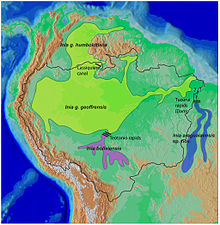Amazon river dolphins
| Amazon river dolphins | ||||||||||||
|---|---|---|---|---|---|---|---|---|---|---|---|---|

Amazon dolphin ( Inia geoffrensis ) |
||||||||||||
| Systematics | ||||||||||||
|
||||||||||||
| Scientific name of the family | ||||||||||||
| Iniidae | ||||||||||||
| JE Gray , 1846 | ||||||||||||
| Scientific name of the genus | ||||||||||||
| Inia | ||||||||||||
| d'Orbigny , 1834 |
The Amazon river dolphins (Iniidae, genus Inia ) are a mammal family and genus from the order of the whales (Cetacea), which are specially adapted to life in freshwater. The currently three known species of this group live in the river system of the Amazon in South America.
features
River dolphins are small whales with a maximum length of 3 meters and 160 kilograms, the La Plata dolphin is even considered one of the smallest whales. Your body is relatively clumsy and the fin is very low. In contrast, the fluke is large and the flippers are wide. The cervical vertebrae are not fused together, which makes the head very mobile. The melon is strongly arched, the muzzle is elongated. The jaws are like tweezers and can contain over 200 teeth in total. The eyes are greatly reduced in size, but still functional.
The Asian ganges dolphins ( Platanista ) differ among other things from the river dolphins in the construction of the skull (ganges dolphins have a unique upper jaw ridge that extends from the base of the skull almost to the blowhole) and in that they have an appendix .
distribution and habitat
All species of the Amazon river dolphins are freshwater inhabitants and live in the river systems of the Amazon in South America.
Way of life
River dolphins are adapted to life in murky, narrow waters. The large flippers and flippers increase maneuverability. Your echolocation system is well developed, but your visual sense is weaker. The long snout is used to dig in the mud and catch fish and other prey. In contrast to the actual dolphins , the river dolphins tend to live solitary.
Systematics
External system
The systematic position of the freshwater-dwelling dolphins is one of the great points of discussion in the whale system . It is not entirely clear whether the numerous morphological similarities of the freshwater animals are due to convergence or to a common ancestry. Accordingly, the four affected taxa, the Amazon dolphin, the La Plata dolphin, the Chinese river dolphin and the ganges dolphin were sometimes grouped into one family (Platanistidae) or at least superfamily (Platanistoidea), but sometimes also classified as the result of pure convergence in four independent families .
Molecular genetic studies came to the conclusion that the Ganges dolphins represent their own developmental line that is not closely related to the other representatives. Hamilton et al. (2001) also classified the Chinese river dolphin in a separate group and only summarized the Amazon and La Plata dolphins. An analysis of the retroposons by Nikaido et al. (2001), on the other hand, came to the conclusion that the Chinese, Amazon and La Plata dolphins represent a monophyletic group, which has also been confirmed, for example, by studies on cytochromes .
Wilson & Reeder (2005) adopted this point of view and classified the Amazon, Chinese and La Plata dolphins in a common family, the Iniidae. A possible cladogram of toothed whales looks like this:
| Toothed whales (Odontoceti) |
|
||||||||||||||||||||||||
|
|
Internal system

According to the currently recognized system, three species are counted among the river dolphins:
- the Amazon dolphin ( Inia geoffrensis ),
- the araguaia dolphin ( Inia araguaiaensis )
- the Bolivian Amazon Dolphin ( Inia boliviensis )
The La Plata dolphin ( Pontoporia blainvillei ) and the Chinese river dolphin ( Lipotes vexillifer ), which has already become extinct, are assigned to their own families. The Inia species and the La Plata dolphin form a common clade, the sister group of which is the Chinese river dolphin. The Ganges dolphins, which are traditionally also placed with the river dolphins, are only distantly related to this group. Also some representatives of the (real) dolphins living in freshwater such as the Sotalia , the Cameroon river dolphin and the Irrawaddy dolphin are not included.
River dolphins and people
Freshwater whales are often more threatened than their marine relatives from water pollution, hunting, accidental killing in fishing nets, and dam construction and other regulatory measures.
literature
- DE Wilson, DM Reeder: Mammal Species of the World. Johns Hopkins University Press, 2005, ISBN 0-8018-8221-4 .
- Milan climate: cetacea, whales. In: Wilfried Westheide, Reinhard Rieger (Ed.): Special Zoology. Part 2: vertebrates or skulls. Gustav Fischer Verlag, Stuttgart / Jena / New York 2003, ISBN 3-8274-0900-4 , pp. 630-644.
- Ronald M. Nowak: Walker's Mammals of the World . Johns Hopkins University Press, 1999, ISBN 0-8018-5789-9 .
Individual evidence
- ^ Healey Hamilton et al .: Evolution of river dolphins. In: Proc. R. Soc. Lond. B, 268, 2001, pp. 549-558. (PDF)
- ↑ Masato Nikaido: Retroposon analysis of major cetacean lineages: The monophyly of toothed whales and the paraphyly of river dolphins. In: Proceedings of the National Academy of Sciences. 98, 2001, pp. 7384-7389. (Abstract)
- ↑ a b Laura May-Collado, Ingi Agnarsson: Cytochrome b and Bayesian inference of whale phylogeny. In: Molecular Phylogenetics and Evolution. 38, 2006, pp. 344-354. (PDF)
- ↑ Tomas Hrbek, Vera Maria Ferreira Da Silva, Nicole Dutra, Waleska Gravena, Anthony R. Martin, Izeni Pires Farias: A New Species of River Dolphin from Brazil or: How Little Do We Know Our Biodiversity. In: PLoS ONE . 9, 2014, p. E83623. doi: 10.1371 / journal.pone.0083623
- ↑ M. Ruiz-García, S. Caballero, M. Martinez-Agüero, JM Shostell: Molecular differentiation among Inia geoffrensis and Inia boliviensis (Iniidae, Cetacea) by means of nuclear intron sequences. In: VT Koven (Ed.): Population Genetics Research Progress. Nova Publishers, Boca Raton, FL, USA 2008, pp. 177-203.